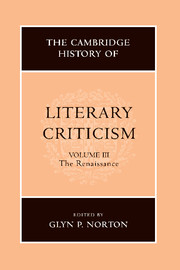Book contents
- Frontmatter
- Introduction
- READING AND INTERPRETATION: AN EMERGING DISCOURSE OF POETICS
- POETICS
- THEORIES OF PROSE FICTION
- CONTEXTS OF CRITICISM: METROPOLITAN CULTURE AND SOCIO-LITERARY ENVIRONMENTS
- VOICES OF DISSENT
- STRUCTURES OF THOUGHT
- 45 Renaissance Neoplatonism
- 46 Cosmography and poetics
- 47 Natural philosophy and the ‘new science’
- 48 Stoicism and Epicureanism: philosophical revival and literary repercussions
- 49 Calvinism and post-Tridentine developments
- 50 Port-Royal and Jansenism
- NEOCLASSICAL ISSUES: BEAUTY, JUDGEMENT, PERSUASION, POLEMICS
- A SURVEY OF NATIONAL DEVELOPMENTS
- Bibliography
- Index
- References
45 - Renaissance Neoplatonism
from STRUCTURES OF THOUGHT
Published online by Cambridge University Press: 28 March 2008
- Frontmatter
- Introduction
- READING AND INTERPRETATION: AN EMERGING DISCOURSE OF POETICS
- POETICS
- THEORIES OF PROSE FICTION
- CONTEXTS OF CRITICISM: METROPOLITAN CULTURE AND SOCIO-LITERARY ENVIRONMENTS
- VOICES OF DISSENT
- STRUCTURES OF THOUGHT
- 45 Renaissance Neoplatonism
- 46 Cosmography and poetics
- 47 Natural philosophy and the ‘new science’
- 48 Stoicism and Epicureanism: philosophical revival and literary repercussions
- 49 Calvinism and post-Tridentine developments
- 50 Port-Royal and Jansenism
- NEOCLASSICAL ISSUES: BEAUTY, JUDGEMENT, PERSUASION, POLEMICS
- A SURVEY OF NATIONAL DEVELOPMENTS
- Bibliography
- Index
- References
Summary
Renaissance Neoplatonism was the creation of the fifteenth-century Florentines Marsilio Ficino and Giovanni Pico della Mirandola and had a profound and far-reaching impact on the cultural as well as the intellectual and religious life of Europe for well over two centuries. It contributed a forma mentis that transcended disciplinary and national boundaries without necessarily coming into direct conflict with other contemporary mind-sets, those we associate with Aristotelianism, Protestantism, Ramism, neo-scholasticism, Hermeticism, Copernicanism, Tridentism, and so forth. Literature and its interpretation only played an ancillary role in what was at heart a philosophico-theological movement anchored in the concerns of medieval Catholicism but inspired by the attractive example of Plato's newly discovered dialogues on the one hand and by the dauntingly technical commentaries of the Neoplatonists on the other. But it did mean that the Platonic dialogue, with its dramatic shifts from interrogation to exposition to myth to fable to quotation to dialectical division in various sequences and combinations, was set up not so much as the literary but as the hermeneutical model; and that Plato's style, with its lucidity, suppleness, and figurative and ironic variety, became acknowledged as a way of doing philosophy that was in marked contrast to the wrangling of the schools and to the analytic systematizing of Aristotle. Plato became not only the great alternative to the Stagirite as a philosopher but a more profound and compelling alternative to Cicero as a model rhetorician.
One of the obvious issues the Platonic dialogue poses is that of genre. Ancient doxologists, such as Diogenes Laertius in his Lives of the philosophers 3.49–51, 58–61, had divided up the dialogues rather crudely under such heads as ‘political’, ‘ethical’, ‘logical’, ‘physical’, and ‘obstetrical’; but this could not satisfy those who were impressed by the dramatic unity of many of Plato's masterpieces and by the complexity and variety that subsisted in that unity.
- Type
- Chapter
- Information
- The Cambridge History of Literary Criticism , pp. 433 - 441Publisher: Cambridge University PressPrint publication year: 1999
References
- 1
- Cited by



